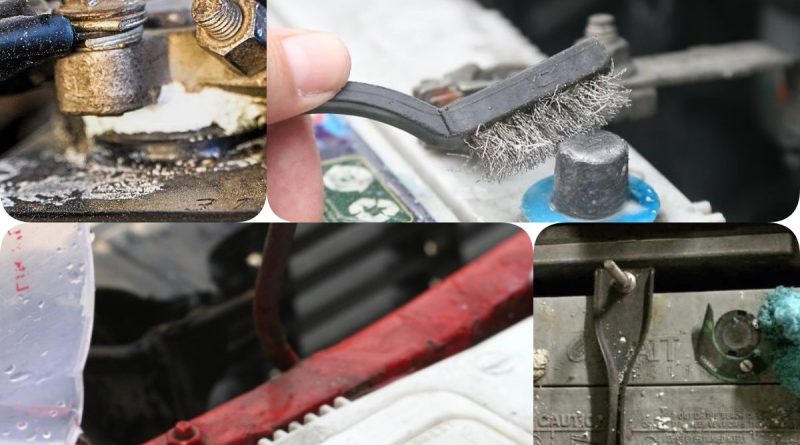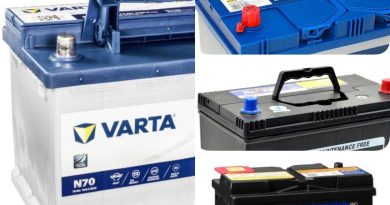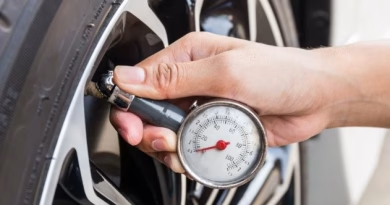How to Clean Car Battery Terminals: Complete Step-by-Step Guide
Know how to clean corroded battery terminals safely at home and outside with step-by-step instructions. Also Prevent starting problems and extend battery life in Nigeria.
Let’s say Corroded battery terminals are one of the most common causes of car starting problems, especially in Nigeria’s humid climate. That white, blue, or green crusty builds up around your battery terminals isn’t just unsightly—it’s actively preventing your car from starting and can lead to expensive electrical problems that might even affect your alternator’s performance.
At Afchargetech, we’ve seen countless vehicles towed in with “dead batteries” that simply needed a good terminal cleaning. Not that maybe the batteries are just dead but due to the corrosion it carries on its pole. This 15-minute maintenance task can save you from roadside breakdowns and extend your battery’s lifespan significantly, especially when paired with choosing the right battery for Nigerian conditions.
In this comprehensive guide, we’ll walk you through the complete process of safely cleaning battery terminals, what causes corrosion, and how to prevent it from returning. stay with us and you can also subscribe to our newsletter to get the latest updates and tips.
Why Battery Terminals Corrode
The Science Behind Corrosion
Battery terminals corrode due to chemical reactions between the lead terminals and battery acid vapors. In Nigeria’s climate, this process accelerates due to:
Environmental Factors:
- High humidity (up to 90% in coastal areas)
- Salt air near coastal regions like Lagos and Port Harcourt
- Dust and particles creating abrasive conditions
- Temperature fluctuations causing expansion and contraction
- Acid vapors escaping from battery vents during charging cycles
Chemical Process:
- Hydrogen gas escapes from battery during charging
- Sulfuric acid vapors react with lead terminals
- Lead sulfate crystals form on terminal surfaces
- Moisture accelerates the corrosion process
- Buildup creates electrical resistance affecting the entire charging system
The relationship between terminal corrosion and charging system problems is critical. When terminals are corroded, your alternator works harder to maintain proper voltage, potentially leading to alternator failure symptoms over time.

Signs of Terminal Corrosion
Visual Indicators:
- White, chalky powder around terminals
- Blue or green crystalline buildup
- Flaky, crusty deposits
- Discolored terminal metal
- Corroded cable connections
Performance Problems:
- Slow engine cranking
- Clicking sounds when starting
- Dim headlights or dashboard lights
- Electrical accessories malfunctioning
- Need for frequent jumpstarting
Tools and Materials Needed
Essential Cleaning Supplies
Basic Cleaning Kit:
- Baking soda (2-3 tablespoons)
- Warm water (1 cup)
- Old toothbrush or wire brush
- Adjustable wrench or socket set
- Disposable rags or paper towels
- Rubber gloves (chemical resistant)
- Safety glasses or goggles
Optional Professional Tools:
- Battery terminal cleaner (commercial solution)
- Battery terminal brush (specialized tool)
- Wire brush for heavy corrosion
- Multimeter for testing connections
- Battery terminal protectant spray
Safety Equipment
Personal Protection:
- Rubber gloves – protect hands from acid
- Safety glasses – prevent splashing in eyes
- Long sleeves – protect arms from acid contact
- Closed-toe shoes – protect feet from spills
- Face mask – avoid inhaling particles
Professional automotive technicians at AutoZone recommend using proper safety equipment, especially in Nigeria’s humid conditions where acid vapors can be more concentrated.
Step-by-Step Cleaning Process
Step 1: Safety Preparation
Before touching anything, ensure your safety:
- Turn off the engine and remove keys
- Engage parking brake for stability
- Allow engine to cool if recently driven
- Work in well-ventilated area – avoid enclosed spaces
- Keep sparks away – no smoking or open flames
- Wear all safety equipment – gloves, glasses, long sleeves
Warning Signs to Stop:
- Strong rotten egg smell (hydrogen sulfide)
- Visible battery damage or swelling
- Wet battery case indicating leaks
- Extremely hot battery (let cool first)
Step 2: Document and Disconnect
Before Disconnecting:
- Take photos of cable connections for reference
- Note radio/security codes that may reset
- Ensure windows are up (power may be lost)
- Turn off all electrical accessories
Disconnection Order:
- Negative terminal first (black cable) – prevents sparks
- Positive terminal second (red cable)
- Wiggle cables gently to free stuck connections
- Set cables aside away from battery
This proper disconnection sequence is crucial for safety and prevents electrical system damage that could affect your alternator’s operation.
Step 3: Create Cleaning Solution
Baking Soda Solution (Most Effective):
- Mix 2-3 tablespoons baking soda with 1 cup warm water
- Stir until completely dissolved
- Solution should be slightly cloudy
- This neutralizes acid and lifts corrosion
Alternative Solutions:
- Commercial terminal cleaner (follow manufacturer instructions)
- Coca-Cola (phosphoric acid dissolves corrosion)
- Lemon juice and salt (natural acid neutralizer)
Leading automotive resource Popular Mechanics confirms that baking soda solution is the safest and most effective method for home use.

Step 4: Apply Cleaning Solution
Application Process:
- Pour solution slowly over corroded terminals
- Watch for fizzing – this indicates neutralization
- Let sit for 2-3 minutes to break down corrosion
- Reapply if necessary for heavy buildup
- Avoid getting solution inside battery cells
What You’ll See:
- Immediate fizzing and bubbling
- Corrosion changing color (usually to brown)
- Loosening of crusty deposits
- Clearing of terminal metal underneath

Step 5: Scrub and Remove Corrosion
Scrubbing Technique:
- Use old toothbrush in circular motions
- Apply moderate pressure – don’t damage terminals
- Work from outside to inside of terminal
- Clean cable ends thoroughly
- Remove all visible corrosion – don’t leave any buildup
For Stubborn Corrosion:
- Wire brush for heavy deposits
- Sandpaper (fine grit) for metal restoration
- Multiple cleaning applications may be needed
- Specialized terminal brush for tight spaces
Step 6: Rinse and Dry
Rinsing Process:
- Use clean water to remove cleaning solution
- Rinse thoroughly – no residue should remain
- Dry immediately with clean rags
- Ensure completely dry before reconnecting
- Check for missed spots and re-clean if needed
Drying Tips:
- Use lint-free rags to prevent debris
- Compressed air can help dry tight spaces
- Allow air drying for 5-10 minutes
- Check cable ends are completely dry

Step 7: Reconnect Properly
Reconnection Order (Reverse of Disconnection):
- Positive terminal first (red cable)
- Negative terminal second (black cable)
- Tighten firmly but don’t over-tighten
- Ensure good metal-to-metal contact
- Test connections by gently wiggling
Proper Tightening:
- Snug but not overtight – prevents terminal damage
- Use proper wrench size – usually 8mm or 10mm
- Check for solid connection – no movement when wiggled
- Avoid stripping threads – turn slowly and carefully
Clean terminals are essential for proper charging system operation. Poor connections can cause your alternator to work harder, potentially leading to premature failure as described in our alternator diagnostic guide.
Advanced Cleaning Techniques
For Extremely Corroded Terminals
Professional-Grade Process:
- Remove battery completely if necessary
- Use commercial acid neutralizer for heavy corrosion
- Wire brush aggressively to remove all buildup
- Sand terminals smooth with fine-grit sandpaper
- Apply corrosion inhibitor before reinstalling
For Difficult Access Situations
Tight Spaces:
- Use flexible brush to reach around obstacles
- Mirror or phone camera to see hidden areas
- Extension tools for deep battery compartments
- Remove air intake or other components if necessary
For Aluminum Terminals
Special Considerations:
- Gentler cleaning – aluminum is softer than lead
- Avoid abrasive brushes that can damage surface
- Use aluminum-safe cleaners only
- Apply protective coating immediately after cleaning
Preventive Maintenance
Protective Coatings
Application After Cleaning:
- Battery terminal protectant spray – most effective
- Petroleum jelly – traditional but messy
- Dielectric grease – professional grade
- Felt washers – absorb acid vapors
- Terminal boots – physical protection
Regular Inspection Schedule
Monthly Checks:
- Visual inspection for early corrosion
- Check terminal tightness
- Clean minor buildup immediately
- Test electrical connections
Quarterly Deep Cleaning:
- Complete terminal cleaning process
- Apply fresh protective coating
- Check cable condition
- Test battery voltage
Environmental Protection
For Nigerian Climate:
- More frequent cleaning during rainy season
- Extra protection in coastal areas
- Covered parking when possible
- Battery blankets for extreme conditions
Regular terminal maintenance is especially important with high-performance batteries designed for Nigerian conditions, as clean connections ensure optimal performance and longevity.
Common Mistakes to Avoid
Safety Mistakes
- Never smoke near batteries
- Don’t disconnect positive first – causes sparks
- Avoid metal jewelry – can cause shorts
- Don’t work in enclosed spaces – dangerous gases
Technical Mistakes
- Over-tightening terminals – damages threads
- Using wrong tools – strips connections
- Not cleaning cable ends – poor connection remains
- Skipping protective coating – corrosion returns quickly
Chemical Mistakes
- Using wrong cleaners – can damage terminals
- Not neutralizing acid – continues corrosion
- Mixing cleaning chemicals – dangerous reactions
- Getting cleaner in battery cells – damages battery
The Car Care Council emphasizes that proper technique is crucial for both safety and effectiveness.
When to Call Professional Help
Situations Requiring Expert Service
Call Afchargetech When:
- Extensive corrosion affecting multiple components
- Battery case damage or swelling
- Electrical problems persist after cleaning
- Uncomfortable with process – safety first
- Lack proper tools or safety equipment
Signs of Deeper Problems
Beyond Simple Cleaning:
- Repeated rapid corrosion – indicates overcharging
- Corroded wiring extending beyond terminals
- Battery not holding charge after cleaning
- Electrical system malfunctions continue
If cleaning doesn’t solve your starting problems, you might be dealing with battery failure symptoms that require professional diagnosis and potentially battery replacement.
Cost-Benefit Analysis
DIY Cleaning Costs
Initial Investment:
- Cleaning supplies: ₦2,000-₦3,000
- Safety equipment: ₦3,000-₦5,000
- Basic tools: ₦5,000-₦8,000
- Total: ₦10,000-₦16,000
Per Cleaning:
- Baking soda and water: ₦100-₦200
- Time investment: 15-30 minutes
- Savings vs. professional: ₦3,000-₦5,000
Professional Service Costs
Afchargetech Service:
- Terminal cleaning: ₦3,000-₦5,000
- Includes testing: Battery health check
- Warranty: Guarantee on work performed
- Convenience: Mobile service available
Long-Term Savings
Regular Maintenance Benefits:
- Extended battery life – 6-12 months additional
- Prevents breakdowns – saves towing costs
- Maintains warranty – proper care required
- Improves performance – better starting reliability
Clean terminals also ensure your alternator operates efficiently, preventing the costly repairs outlined in our alternator failure guide.
Environmental Considerations
Proper Disposal
Safe Waste Management:
- Neutralize waste water before disposal
- Never pour down drains – environmental damage
- Use absorbent materials for spills
- Dispose of rags properly – may contain lead
Eco-Friendly Alternatives
Green Cleaning Options:
- Baking soda – natural and safe
- Vinegar solution – biodegradable
- Lemon juice – natural acid
- Avoid harsh chemicals when possible
Troubleshooting After Cleaning
If Problems Persist
Check These Issues:
- Incomplete cleaning – corrosion remains
- Loose connections – retighten terminals
- Damaged cables – may need replacement
- Battery failure – cleaning won’t fix dead battery
- Alternator problems – not charging properly
Testing Your Work
Verification Steps:
- Voltage test – should read 12.6V minimum
- Load test – check under electrical load
- Connection test – ensure tight fit
- Performance test – car should start normally
If your vehicle still won’t start after cleaning, you might need to jumpstart your battery or investigate more serious electrical issues.
Regional Maintenance Tips
Northern Nigeria (Kano, Kaduna, Abuja)
Dust Considerations:
- More frequent cleaning due to harmattan dust
- Protective covers during dust storms
- Sealed terminal boots recommended
- Monthly inspections during dry season
Middle Belt (Jos, Ilorin, Minna)
Temperature Variations:
- Thermal expansion affects connections
- Seasonal maintenance adjustments needed
- Monitor during temperature extremes
- Altitude considerations for plateau areas
Southern Nigeria (Lagos, Port Harcourt, Calabar)
Coastal Challenges:
- Salt air accelerates corrosion
- Marine-grade protectants recommended
- Weekly visual checks during rainy season
- Humidity control when possible
Conclusion: Maintain Your Power Connection
Clean battery terminals are essential for reliable vehicle operation. This simple maintenance task, performed regularly, can prevent countless roadside emergencies and extend your battery’s life significantly.
In Nigeria’s challenging climate, terminal corrosion happens faster than in temperate regions. Regular cleaning isn’t just recommended—it’s essential for maintaining reliable transportation and protecting your entire electrical system.
Key Takeaways:
- Clean terminals monthly for best results
- Use baking soda solution for safe, effective cleaning
- Apply protective coating after each cleaning
- Follow safety procedures always
- Call professionals when in doubt
Remember: If you’re seeing signs of a dying battery beyond just corrosion, terminal cleaning alone won’t solve the problem. A comprehensive battery test may be needed, and you should also check for alternator problems that might be causing premature battery failure.
Need Help? Contact Afchargetech for professional terminal cleaning, battery testing, or mobile service. Our technicians carry all necessary tools and safety equipment for safe, effective terminal maintenance.
Contact Information:
- Website: Afchargetech.com
- WhatsApp: +2349127256156
- YouTube: @Afchargetech
Don’t let corroded terminals leave you stranded. Take control of your battery maintenance and enjoy worry-free driving.
Related Articles you should read:



